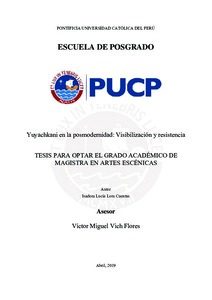| dc.contributor.advisor | Vich Flores, Víctor Miguel | |
| dc.contributor.author | Lora Cuentas, Isadora Lucía | es_ES |
| dc.date.accessioned | 2019-10-16T17:47:44Z | es_ES |
| dc.date.available | 2019-10-16T17:47:44Z | |
| dc.date.available | 2019-10-16T17:47:44Z | es_ES |
| dc.date.created | 2019 | es_ES |
| dc.date.issued | 2019-10-16 | es_ES |
| dc.identifier.uri | http://hdl.handle.net/20.500.12404/15182 | |
| dc.description.abstract | El grupo cultural Yuyachkani ha ido modificando las estructuras formales de sus obras
a partir del año 2000, cuando las características de la posmodernidad se empezaron a instalar
en nuestra cultura a partir de la globalización, modificando al sujeto y su relación con el tiempo
y el espacio.
A partir del arribo de la posmodernidad, el sujeto se fragmenta y el tiempo se
espacializa, al mismo tiempo que esto genera un correlato en los objetos culturales que este
sujeto produce. En el caso del teatro, que es también un objeto cultural, la fábula, el conflicto
y los personajes (con propósito) le dan paso a las estructuras y personajes fragmentados,
híbridos, plurales y heterogéneos. Yuyachkani no escapa a esta realidad, por el contrario, es en
las últimas producciones del grupo donde estas características se ven progresivamente con
mayor claridad y contundencia.
En el presente trabajo se analizan tres espectáculos del grupo: Hecho en el Perú:
vitrinas para la memoria, Sin Título, técnica mixta y Discurso de promoción, que fueron
estrenados en los años 2001, 2004 (con varios reestrenos desde entonces) y 2017
respectivamente, usando a la posmodernidad como categoría de análisis para demostrar cómo
se presentan las características de la posmodernidad previamente mencionadas y cómo, al
mismo tiempo, estas son resignificadas para a partir de ellas construir un nuevo teatro político.
Para hacerlo este trabajo se apoya en algunos supuestos teóricos como la deconstrucción
derridiana, la fractura de la cadena significante de Jameson y el reparto de lo sensible que
plantea Rancière, entre otros, para a partir de ellos, estudiar las características formales de las
obras en cuestión.
Finalmente, este trabajo de investigación pretende demostrar que es posible construir
un contra relato al ubicar al espectador en un rol protagónico que le permita rearticular lo
fragmentado, plural, descentrado y heterogéneo que despliegan en escena estas tres
producciones del grupo, para así abrir el campo de posibilidades en relación a la lectura de la
historia y la realidad del país, y con esto generar una postura crítica, es decir, política por parte
de los espectadores. | es_ES |
| dc.description.abstract | Yuyachkani cultural group has been modifying the formal structures of its plays since
2000, when the characteristics of postmodernity began to be installed in our culture modifying
since globalization, modifying the subject and its relation with time and space.
From the arrival of postmodernity, the theme is fragmented and time is spatialized, at
the same time that this generates a correlation in the cultural objects that this subject produces.
In the case of the theater, which is also a cultural object, the fable, the conflict and the characters
(with purpose) give way to fragmented, hybrid, plural and heterogeneous structures and
characters. Yuyachkani does not escape this reality, on the contrary, it is in the last productions
of the group where these characteristics are progressively seen with greater clarity and
forcefulness.
In the present work three plays of the group will be analyzed, Hecho en el Perú: vitrinas
para la memoria (Made in Peru: showcases for memory), Sin Título, técnica mixta (Untitled,
mixed technic) and Discurso de promoción (Graduation speech), which where premiered in
2001, 2004 (whit several reruns since) and 2017 respectively, using postmodernity as a
category of analysis to demonstrate how the previously mentioned characteristics of
postmodernity are presented and how, at the same time, these are resignified to build a new
political theater from them.
In order to do so, this work is based on some theoretical assumptions such as the
Derridian deconstruction, Jameson's fracture of the significant chain and Rancière’s
distribution of the sensible, among others, to study the formal characteristics of the plays in
question.
Finally, this research work aims to demonstrate that it is possible to build a counter
story by placing the viewer in a leading role that allows him to rearticulate the fragmented,
plural, decentralized and heterogeneous that these three productions of the group display on
stage, in order to open the field of possibilities in relation to the reading of the history and the
reality of the country, and with this generate a critical stance, that is, political on the part of the
spectators. | es_ES |
| dc.language.iso | spa | es_ES |
| dc.publisher | Pontificia Universidad Católica del Perú | es_ES |
| dc.rights | Atribución-CompartirIgual 2.5 Perú | * |
| dc.rights | info:eu-repo/semantics/openAccess | es_ES |
| dc.rights.uri | http://creativecommons.org/licenses/by-sa/2.5/pe/ | * |
| dc.subject | Grupo Cultural Yuyachkani | es_ES |
| dc.subject | Teatro peruano--Siglo XXI | es_ES |
| dc.subject | Teatro peruano--Aspectos políticos | es_ES |
| dc.subject | Teatro peruano--Crítica e interpretación | es_ES |
| dc.title | Yuyachkani en la posmodernidad: visibilización y resistencia | es_ES |
| dc.type | info:eu-repo/semantics/masterThesis | es_ES |
| thesis.degree.name | Magíster en Artes Escénicas | es_ES |
| thesis.degree.level | Maestría | es_ES |
| thesis.degree.grantor | Pontificia Universidad Católica del Perú. Escuela de Posgrado | es_ES |
| thesis.degree.discipline | Artes Escénicas | es_ES |
| renati.discipline | 215047 | es_ES |
| renati.level | https://purl.org/pe-repo/renati/level#maestro | es_ES |
| renati.type | http://purl.org/pe-repo/renati/type#tesis | es_ES |
| dc.publisher.country | PE | es_ES |
| dc.subject.ocde | http://purl.org/pe-repo/ocde/ford#6.04.04 | es_ES |






